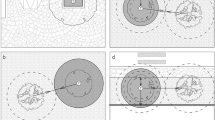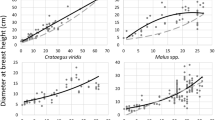Abstract
Urban conditions are known to affect tree growth, but not all trees respond similarly to presumed stress. I test a hypothesis that successional status of hardwood tree species, rather than taxon, will differentially affect tree size relative to age, in forest versus street plantings. In central Ohio, USA, samples (N = 230) representing 15 native tree species were matched for size between rural woodlot and city street-side conditions. Their girth was measured and their age determined by a count of annual growth rings. Age and size data were analyzed by a general linear model. Most urban trees had smaller trunk diameters than rural conspecifics of the same age. However, trees of early and mid-successional ecologies, despite smaller girth, showed no reduction in growth rate over time. Late successional species appeared to be affected by proximity to impervious areas, showing reduced growth rates, and by inference,reduced ultimate size.
Similar content being viewed by others
References
Braun, E.L. (1964) Deciduous Forests of Eastern North America. Hafner Pub. Co, New York, NY.
Burns, R.M. and Honkala, B.H. (1990) Silvics of North America, vol. 2, Hardwoods. Agriculture Handbook #654, Forest Service, USDA, Washington, D.C.
Canfield, B. and Runkle, J.R. (1999) Size structure and composition of trees in Oakwood, Ohio: Historical and environmental determinants. Ohio Jour. Sci. 99, 102–110.
Close, R.E., Nguyen, P.V. and Kielbaso, J.J. (1996a) Urban vs. natural maple sugar growth: I. Stress symptoms and phenology in relation to site characteristics. J. Arboriculture 22, 144–150.
Close, R.E., Kielbaso, J.J., Nguyen, P.V. and Schutski, R.E. (1996b) Urban vs. natural sugar maple growth: II. Water relations. J. Arboriculture 22, 187–192.
Cregg, B.M. and Dix, M.E. (2001) Tree moisture stress and insect damage in urban areas in relation to heat island effects. J. Arboriculture 27, 8–17.
Day, S.D., Bassuk, N.L. and van Es, H. (1995) Effects of fours compaction remediation methods for landscape trees on soil aeration, mechanical impedance and tree establishment. J. Env. Hort. 13, 64–71.
Dorney, J.R., Guntenspergen, G.R., Keough, J.R. and Stearns, F. (1984) Composition and structure of an urban woody plant community. Urban Ecol. 8, 69–90.
Dwyer, J.F. et al. 2002. Future directions for urban forestry research in the United States. J. Arboriculture 28, 231–235.
Fowells, H.A. and Means, J.E. (1990) The tree and its environment. In Silvics of North America, vol. 2, Hardwoods. Agriculture Handbook 654, U.S. Forest Service, USDA, Washington, DC.
Gayek, A. and Quigley, M.F. (2000) Does habitat variation affect the rate and success of colonization of L. maackii and Ligustrum vulgare in a forested glen in southwestern Ohio? Ohio J. Sci. 101, 95–100.
Gilman, E.F. (1988) Prediction of root spread from trunk diameter and branch spread. J. Arboriculture 14, 85–89.
Grabosky, J. and Bassuk, N.L. (1995) A new urban tree soil to safely increase rooting volumes under sidewalks. J. Arboriculture 21, 187–201.
Hightshoe, G.L. (1988) Native Trees, Shrubs and Vines for Rural and Urban America. John Wiley and Sons, New York, NY.
Hodge, S.J. and Boswell, R. (1993) A study of the relationship between site conditions and urban tree growth. J. Arboriculture 19, 358–366.
Lesser, L.M. (1996) Street tree diversity and DBH in southern California. J. Arboriculture 22, 180–186.
Poracsky, J. and Scott, M. (1999) Industrial-area street trees in Portland, Oregon. J. Arboriculture 25, 9–17.
Quigley, M.F. (2003) Franklin Park: 150 years of changing design, disturbance, and impact on tree growth. Urban Ecosystems (in press).
Rhoades, R.W. and Stipes, R.J. (1999) Growth of trees on the Virginia Tech campus in response to various factors. J. Arboriculture 25, 211–216.
Rowntree, R.A. (1998) Urban forest ecology: Conceptual points of departure. J. Arboriculture 24, 62–71.
Sanders, R. and Stevens, J.C. (1984) Urban forests of Dayton, Ohio: a preliminary assessment. Urban Ecol. 8, 91–98.
SAS Institute, Inc. (1993) SAS/STAT User's Guide. Release 6.12, Cary, NC.
Schoeneman, R.S. and Ries, P.D. (1994) Urban forestry: Managing the forests where we live. Journal of Forestry 94, 6–10.
USDA (1980) Soil Survey of Pickaway County, Ohio. USDA Soil Conservation Service, in cooperation with Ohio Department of Natural Resources, Division of Lands and Soil, and Ohio Agricultural Research and Development Center.
USDA (1991) Soil Survey of Franklin County, Ohio. USDA Soil Conservation Service, in cooperation with Ohio Department of Natural Resources, Division of Lands and Soil, and Ohio Agricultural Research and Development Center.
Whitlow, T.H. and Bassuk, N.L. (1987) Trees in difficult sites. J. Arboriculture 13, 10–17.
Author information
Authors and Affiliations
Rights and permissions
About this article
Cite this article
Quigley, M.F. Street trees and rural conspecifics: Will long-lived trees reach full size in urban conditions?. Urban Ecosystems 7, 29–39 (2004). https://doi.org/10.1023/B:UECO.0000020170.58404.e9
Issue Date:
DOI: https://doi.org/10.1023/B:UECO.0000020170.58404.e9




